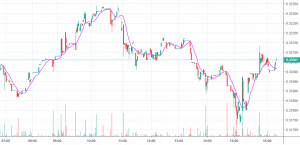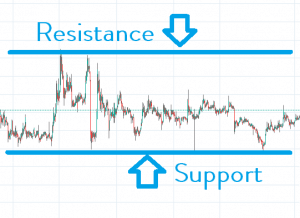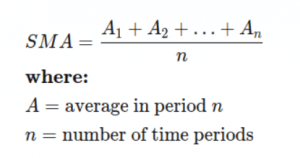What are moving averages?
Moving averages are typically shown as a line on a chart, showing a mean of a previous set of periods. Because they are the mean (or average) of the data, they help to show the general trend without the more extreme price movements (or “noise”) that occur along the way. For instance, if a stock or crypto asset makes a sudden spike upwards, and quickly retreats to where it started, this will not show on a moving average as it would the normal price chart.

The moving average is using past periods to calculate it, so is therefore a “lagging” indicator, or “trend-following” indicator.
What are they used for?
The above definition of the moving average would be known as the ‘simple moving average’ or ‘SMA’. But there is another version called the ‘exponential moving average’, or ‘EMA’, which gives a greater significance to the more recent period prices.
These can then be used to visually map the direction of the asset, as well as show support and resistance levels. A support level is a lower point at which the asset is not expected to go below, and a resistance level is a higher point at which the asset will have a difficult time breaking above.

The formula for Simple Moving Average is:

The formula for Exponential Moving Average is:

How do I use moving averages?
As moving averages are lagging indicators, the greater the number of periods used, the more the average will lag the current trend of the market. Generally, longer moving averages are used by long term traders, and shorter moving averages by short term traders.
If a moving average is moving upwards, this suggests a security or crypto asset is in an uptrend, and similarly if it’s moving downward, this suggests it is in a downtrend.
A common indicator used by crypto traders is to use a long term moving average on the same chart as a short term moving average. For example, the 200-day average and the 20-day average. This can be useful for observing crossovers. When a short term moving average crosses above a long-term moving average, this is seen as bullish. Conversely, when a short-term moving average crosses below a long-term moving average, this signals a bearish market.
Conclusion
As with all trading analysis tools, they should be used with caution and an overall understanding of markets. No concept, including analysing moving averages, is guaranteed to be successful. So as many in the crypto community warn, “DYOR” or Do Your Own Research!
Disclaimer: The views and opinions expressed by the author should not be considered as financial advice. We do not give advice on financial products.
